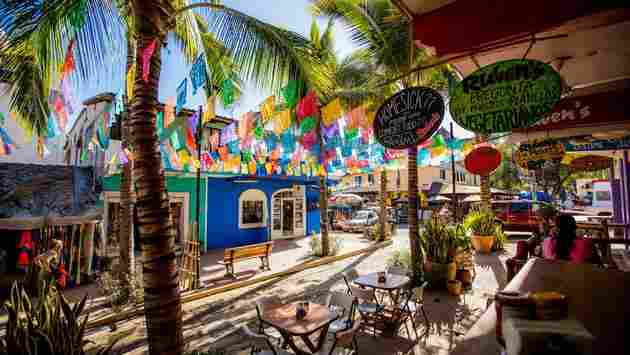More people are vaccinated . More businesses are open and welcoming visitors. But what’s it really like to travel in Mexico today?

During my most recent trip, I visited multiple cities in three Mexican states, took various types of transportation and inspected accommodations both high-end and budget-friendly. I came back with a comprehensive overview of what travelers can expect throughout Mexico at this phase of the pandemic.
The first thing to keep in mind is that, similar to the United States, Mexico deals with the COVID-19 pandemic on a state-by-state basis. That means that each state may have a different alert status, so it’s worth checking before visiting any destination. In Mexico, the monitoring system is based loosely on the concept of a four-tiered traffic light, with red being the highest alert level, followed by orange, yellow and green. Based on the color, certain types of businesses and facilities may be closed or have limited capacity. During my visit, all three states were at the orange alert level, which meant that restaurants had limited capacity and live theater performances were not allowed, among other restrictions.
For the most part, many or most attractions, businesses and other venues are open in Mexico, at least partially, except when a destination is declared “red.” Regardless of the color status, some features are consistently present throughout the country during the pandemic. This includes hand sanitizer and masks, which are currently required in nearly every aspect of public life throughout Mexico. Temperature checks are too, at the airports and in many businesses and major attractions.
In Mexico City , for example, temperature checks, capacity limits and hand sanitizer are the norms at restaurants, museums and stores (in many places, an attendant stands at the entrance to give visitors a squirt of hand sanitizer; one friend told me his hands felt drunk from all the alcohol that was rubbed into them during his most recent visit). Restaurants close earlier than usual (by 10 or 11 p.m.), but many now offer outdoor seating, which is usually a pleasant experience, given the city’s agreeable climate.
As elsewhere in the country, hotels in Mexico City are especially strict about pandemic protocols; they’re also rather good about inventing creative ways to improve the experience. During sumptuous lunches at both the InterContinental Presidente Mexico City and the St. Regis Mexico City, for example, I savored meals at brand-new, open-air dining venues designed to foster safer dining environments with upscale flair. As at all restaurants I visited, both hotel venues followed the now-common practice of cleaning the table with disinfectant when the guest sits down. The St. Regis venue even provided a paper bag to put my face mask in, so it wouldn’t touch the table.
While the dining experience continues to be fairly normal, visitors shouldn’t plan on attending indoor theater performances, dancing at nightclubs or partaking in any other indoor live entertainment. We did find an excellent, open-air dance performance on the rooftop of a venue called Casa Franciscana, however, so there are still options.
Getting around Mexico’s larger cities is relatively unchanged; Uber requires masks, and drivers sometimes provide hand sanitizer. The Mexico City Metro is sometimes quite crowded so it’s not the best option for those looking to practice social distancing. The same goes for Mexico’s long-distance buses; while first-class services like ADO GL fumigate buses at the station, take temperatures at the boarding gate and furnish buses with clear plastic headrest dividers, the lack of space and ventilation onboard makes this far from the most hygienic way to travel during the pandemic.
Other cities in Mexico follow similar protocols. We had our temperatures checked at multiple restaurants and the spectacular Anthropology Museum in Xalapa, received heaping helpings of hand sanitizer at the International Baroque Museum in Puebla and had to skip the teleférico cable car ride since its small cabins were closed due to pandemic safety measures.
Elsewhere in Mexico’s interior, various attractions have made adjustments to provide safer experiences. In the town of Tequila, some distilleries are open at reduced capacity for tours, while Mundo Cuervo offers tastings coupled with a virtual tour of its facility. And in Tlaquepaque, the popular tourist neighborhood in Guadalajara, visitors must have their temperature checked and walk through a sanitizing tent before entering the main pedestrian street.
Mexico’s much-visited coastal destinations continue to modify their approach to meet current realities, as well. Careyes, the upscale development in Jalisco’s Costalegre region, requires residents and visitors to show proof of a negative COVID-19 test. Hotels and attractions in the Mexican Caribbean , Los Cabos, Puerto Vallarta and Riviera Nayarit all follow strict safety guidelines. Xcaret, the ecological park in the Riviera Maya, for example, follows measure established by the International Association of Amusement Parks and Attractions, with extensive disinfecting of items like footwear and aquatic gear.
Regardless of the destination in Mexico, all travelers flying back to the United States — whether vaccinated or not — must present negative results from a COVID-19 performed within 72 hours before departure. Destinations large and small are making it easier to get those tests, with onsite testing (sometimes for free) at many large resort hotels. Urban centers in Mexico City and Guadalajara provide inexpensive testing options at many pharmacies and even onsite at the airports.
The Mexico travel experience may not be back to normal yet, but for those willing to follow the protocols and take the appropriate measures to stay safe, it can still be a rewarding experience.
